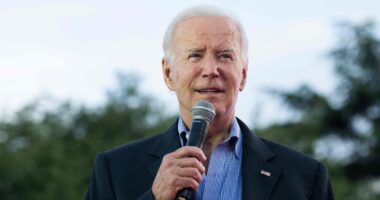With six more states having expanded eligibility for Covid-19 vaccinations, every American aged 16 and older who wants a shot can get one. The question now is just how many actually want it.
On Wednesday, President Biden introduced a tax credit for small businesses to offset paid leave for employees to get a Covid-19 vaccine dose, part of an effort to spur hesitant Americans to get vaccinated. The announcement came amid signs that the pace of vaccinations is slowing.
SHARE YOUR THOUGHTS
How would you grade the vaccine rollout in your state? Join the conversation below.
The Biden administration reached its goal this week of giving 200 million doses within the president’s first 100 days. But there are signs that supply may be outstripping demand. Some states that led the way early in the vaccine rollout are finding it difficult to sustain that success. In mid-February, Alaska, New Mexico and West Virginia saw at least one in seven residents get a shot, ahead of the one-in-10 rate nationally. But as vaccine eligibility has expanded, many of those early advances have slowed. Today, only New Mexico remains in the top 20 states for vaccination rates.

Covid-19 vaccine doses administered per 100,000 people
Eligibility expanded to 16 and older in March
Two-week
average

Covid-19 vaccine doses administered per 100,000 people
Eligibility expanded to 16 and older in March
Two-week
average

Covid-19 vaccine doses administered per 100,000 people
Eligibility expanded to 16 and older in March
Two-week
average

Covid-19 vaccine doses administered
per 100,000 people
Two-week
average
Eligibility expanded to
16 and older in March
Early leaders in the vaccine rollout have been overtaken by states on the East and West Coasts, as vaccinations there have increased. Even as states expanded eligibility beyond the initial priority groups, the upward trend in getting shots in arms is stalling, especially in the South and the Mountain West.
Those states top the list in terms of vaccine hesitancy, according to a recent large-scale survey from the Census Bureau. Developed in concert with the Centers for Disease Control and Prevention and the National Center for Health Statistics, the survey, conducted March 17-29, gauged responses from nearly 80,000 adults.
Nationally, demographic divides persist in Americans’ willingness to get vaccinated. While surveys earlier this year found racial and ethnic splits in vaccine hesitancy, those gaps have largely disappeared. What remains are gaps between younger and older Americans, and those with and without college degrees.

Percentage who say they definitely or probably won’t get a Covid-19 vaccine
Less than
high school
High
school
Some
college
College degree
or higher

Percentage who say they definitely or probably won’t get a Covid-19 vaccine
Less than
high school
High
school
Some
college
College degree
or higher

Percentage who say they definitely or probably won’t get a Covid-19 vaccine
Less than
high school
High
school
Some
college
College degree
or higher

Percentage who say they definitely or
probably won’t get a Covid-19 vaccine
Less than
high school
High
school
Some
college
College degree
or higher
A separate national survey, conducted by the Kaiser Family Foundation, also found deep divisions along party lines, with Republicans nearly three times as likely as Democrats to express some hesitancy. Rural Americans are also more resistant to getting vaccinated.

Percentage who say they are hesitant about getting the Covid-19 vaccine
Definitely won’t get vaccine
Only if required
Wait and see
By party identification
Republican
Independent
By type of area

Percentage who say they are hesitant about getting the Covid-19 vaccine
Definitely won’t get vaccine
Only if required
Wait and see
By party identification
Republican
Independent
By type of area

Percentage who say they are hesitant about getting the Covid-19 vaccine
Definitely won’t get vaccine
Only if required
Wait and see
By party identification
Republican
Independent
By type of area

Percentage who say they are hesitant about
getting the Covid-19 vaccine
Definitely won’t get vaccine
Wait and see
Only if required
By party identification
Republican
Independent
By type of area
The level of vaccine resistance suggests the country is nearing a plateau, according to Kaiser. In an analysis released Tuesday that accounts for current vaccination rates and their own survey data on willingness to receive a vaccine, the health-policy nonprofit estimates the country is just a few weeks away from vaccinating all adults who want to be.

Estimated number of days it would take to reach all adults in the U.S. who want a Covid-19 vaccine with
at least one dose
No change
in current
vaccine
hesitancy
One-third of
‛wait and see’
group now
wants vaccine
Half of this
group now
wants the
vaccine

Estimated number of days it would take to reach all adults in the U.S. who want a Covid-19
vaccine with at least one dose
No change
in current
vaccine
hesitancy
One-third of
‛wait and see’
group now
wants vaccine
Half of this
group now
wants the
vaccine

Estimated number of days it would take to reach all adults in the U.S. who want a
Covid-19 vaccine with at least one dose
No change
in current
vaccine
hesitancy
One-third of
‛wait and see’
group now
wants vaccine
Half of this
group now
wants the
vaccine

Estimated number of days it would take to
reach all adults in the U.S. who want a
Covid-19 vaccine with at least one dose
No change
in current
vaccine
hesitancy
One-third of
‛wait and see’
group now
wants vaccine
Half of this
group now
wants the
vaccine
Importantly, the report notes that over time, people have moved from the “wait and see” group to the vaccine enthusiasm group. State and federal government officials are stepping up efforts to persuade more hesitant Americans to join that group.
Copyright ©2020 Dow Jones & Company, Inc. All Rights Reserved. 87990cbe856818d5eddac44c7b1cdeb8








